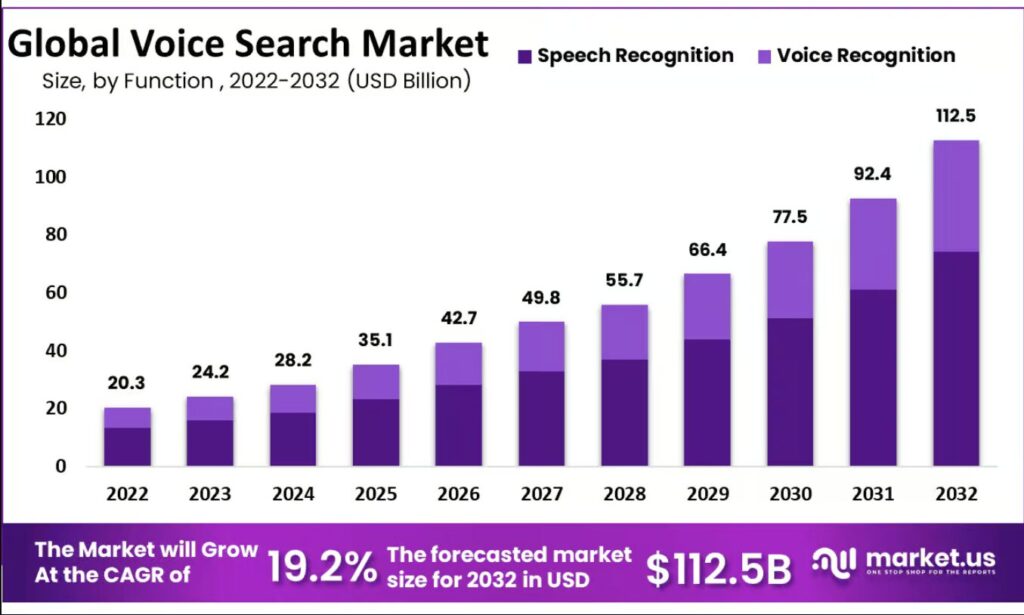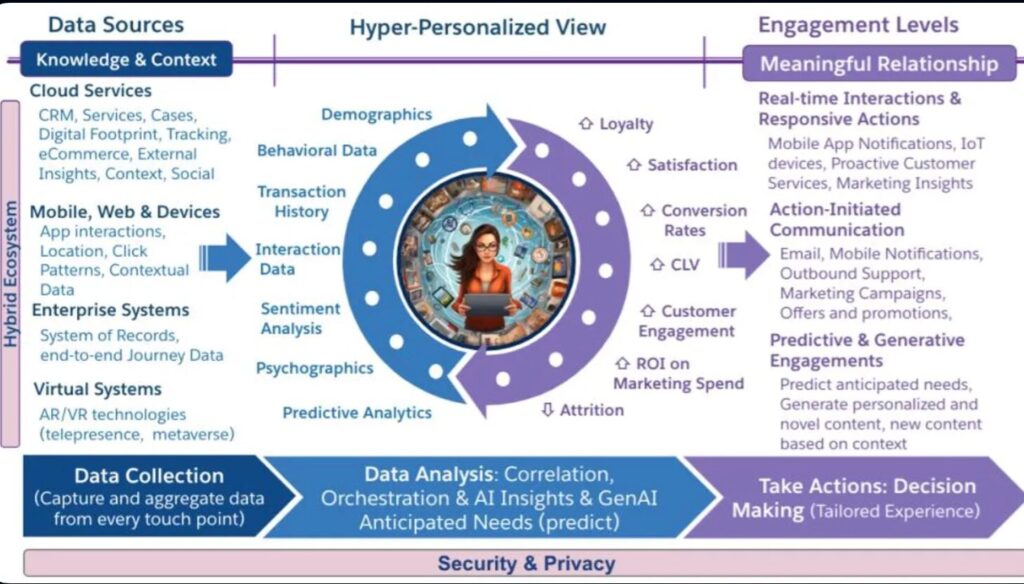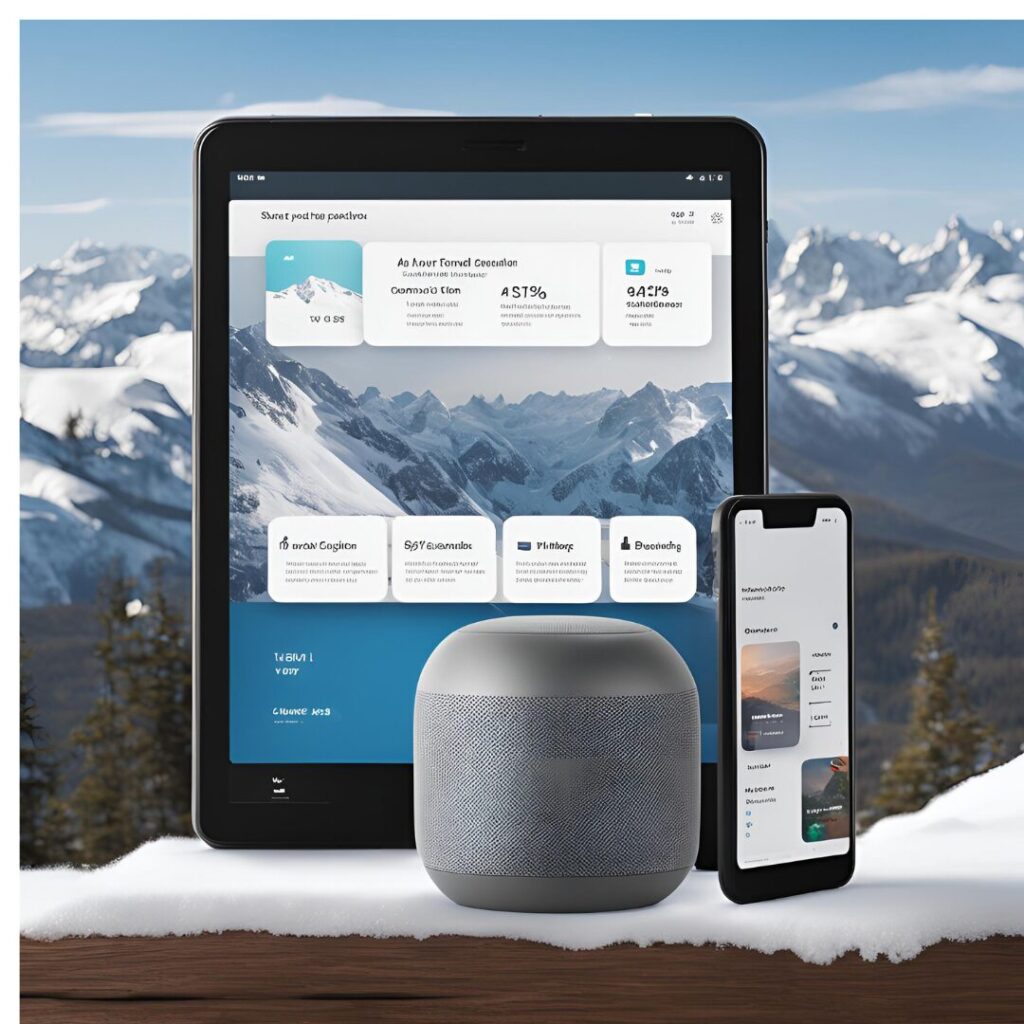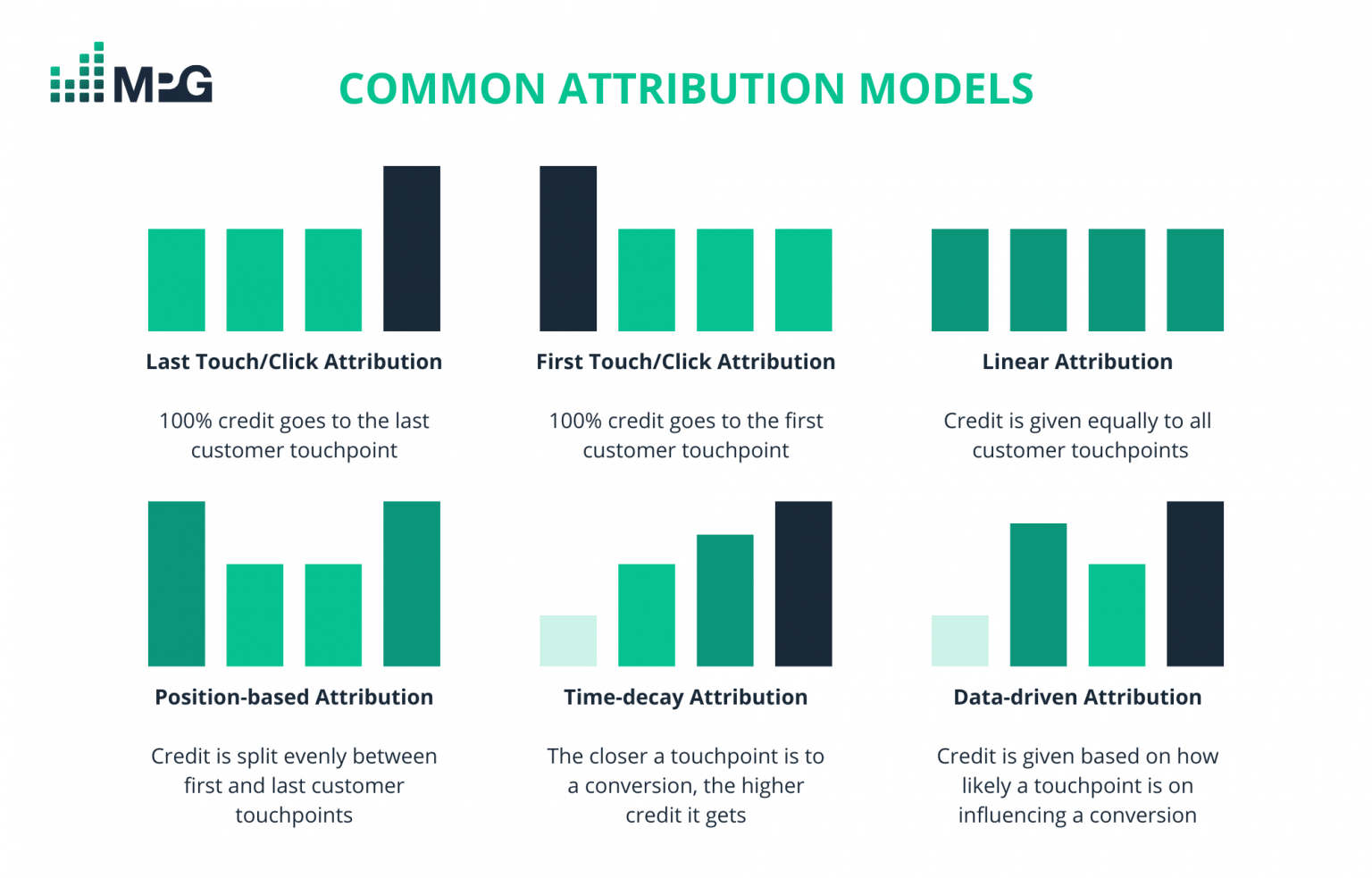How Voice Search and Personalized CX are Shaping the Future of Customer Engagement
Introduction: The Dawn of a New Era in Customer Experience
The digital landscape is in constant flux, driven by evolving consumer behaviours and technological advancements. Two powerful forces are currently reshaping how businesses interact with their customers: voice search and personalized customer experiences (CX). These trends are not isolated phenomena; they intersect and amplify each other, creating a new paradigm for customer engagement. This article explores how voice search and personalized CX are transforming the future of business, examining their impact, providing real-world examples, and offering insights into how businesses can leverage these trends to thrive.
(Image: A person speaking to a smart speaker, with personalized product recommendations appearing on a nearby tablet.)
Understanding Voice Search Technology
Voice search technology represents a revolutionary leap forward in human-computer interaction, allowing users to perform searches using natural language spoken commands rather than typing them out manually. This capability is powered by sophisticated algorithms capable of recognizing speech patterns and converting them into actionable search queries. According to recent studies, voice search isn’t merely a fleeting trend—it marks a pivotal change in how consumers interact with digital content, emphasizing convenience and accessibility over traditional methods.
The mechanics behind voice search involve several critical components working together seamlessly. First, there’s the audio input captured through microphones embedded within smart devices like smartphones, tablets, or dedicated voice assistants such as Amazon Alexa or Google Assistant. Once recorded, this audio data undergoes pre-processing steps including noise reduction and feature extraction before being fed into automatic speech recognition (ASR) systems designed to transcribe spoken words into text form accurately. Following transcription, natural language processing (NLP) techniques analyse the intent behind each query, enabling precise responses based on contextually relevant information retrieved from vast databases indexed across the web.
This entire process happens almost instantaneously, providing users with rapid answers to their questions while maintaining high levels of accuracy even when dealing with complex sentences or ambiguous terms. Moreover, continuous improvements driven by machine learning models ensure ongoing enhancement of both ASR and NLP capabilities, further refining the quality of interactions over time. As a result, businesses must adapt quickly to incorporate voice search optimization strategies into their marketing plans if they wish to remain competitive in an increasingly vocal marketplace.
Evolution of Personalized Customer Experiences
- Personalization has evolved from basic demographic segmentation to hyper-personalization.
- AI-driven insights analyse vast amounts of user data, such as browsing history and purchase patterns.
- Hyper-personalization anticipates needs and offers solutions at the right time.
- E-commerce platforms now suggest products based on real-time trends and inventory availability.
The Rise of Voice Search
Voice search, powered by advancements in natural language processing (NLP) and artificial intelligence (AI), has exploded in popularity. Consumers are increasingly comfortable using voice commands to interact with their devices, search for information, and make purchases. This shift is driven by convenience, speed, and the natural human tendency to communicate through speech.
- Convenience: Voice search offers a hands-free, frictionless way to access information and services, especially useful when multitasking or on the go.
- Speed: Speaking is often faster than typing, making voice search a more efficient way to find what you need.
- Natural Communication: Voice search allows users to express themselves in a natural, conversational way, rather than having to formulate precise keyword queries.

(Image: A chart showing the growth of voice search usage over time.)
According to Statista, the number of voice assistant users worldwide is projected to reach billions in the coming years. This widespread adoption has significant implications for businesses, requiring them to adapt their strategies to cater to this growing segment of consumers.
The Power of Personalized CX
In today’s competitive market, providing a generic customer experience is no longer sufficient. Consumers expect personalized interactions that demonstrate an understanding of their individual needs and preferences. Personalized CX involves tailoring every touchpoint of the customer journey to create a unique and relevant experience for each individual.
- Increased Engagement: Personalized experiences lead to higher levels of customer engagement, as consumers feel valued and understood.
- Improved Loyalty: When businesses consistently deliver personalized experiences, they build stronger relationships with their customers, fostering loyalty and advocacy.
- Higher Conversion Rates: Personalized recommendations and offers are more likely to resonate with customers, leading to increased conversion rates and revenue.

(Image: A graphic illustrating the different components of a personalized customer experience.)
Personalization can manifest in various ways, from personalized product recommendations and targeted marketing campaigns to customized website experiences and proactive customer support. Accenture highlights the value of personalization, emphasizing its impact on customer satisfaction and business growth.
The Intersection of Voice Search and Personalized CX
The true power of these trends emerges when they intersect. Voice search provides a wealth of data about customer preferences, intent, and context, which can be used to personalize the customer experience in real-time. Imagine a customer using voice search to ask their smart speaker for recommendations for a new restaurant. By leveraging data about the customer’s past dining experiences, dietary restrictions, and location, the smart speaker can provide highly personalized recommendations.
(Image: A person using voice search to find personalized recommendations on their phone.)
Synergy Between Voice Search and Personalized CX
- Combining voice search with personalized CX creates a powerful synergy.
- Brands can deliver instant, contextually appropriate responses.
- This strengthens trust, loyalty, and emotional connections with customers.
- For example, travel apps can suggest flights, accommodations, and local attractions in one interaction.
Case Studies Illustrating Successful Integration
- Starbucks : The “My Starbucks Barista” feature lets customers place orders via voice commands, using saved preferences for customization.
- Domino’s Pizza : The “Domino’s AnyWare” platform supports multiple voice-activated devices for ordering, tracking, and receiving updates.
- Both examples demonstrate how integrating voice technology with personalization enhances convenience and satisfaction.
This synergy between voice search and personalized CX creates opportunities for businesses to:
- Anticipate Customer Needs: By analysing voice search queries, businesses can gain insights into what customers are looking for and proactively offer relevant solutions.
- Deliver Contextual Experiences: Voice search provides context about the user’s situation, such as their location or the device they are using, allowing businesses to tailor the experience accordingly.
- Build Deeper Relationships: Personalized voice interactions create a more human-like experience, fostering a sense of connection and trust between the customer and the business.
What are some practical steps for implementing voice search technology in an e-commerce platform?
Optimize Product Pages : Ensure that all product information is detailed and includes natural language descriptions. This makes it easier for voice search algorithms to match queries with relevant products 3.
Leverage Conversational Keywords : Incorporate conversational keywords and phrases that reflect how people naturally speak when searching for items. For instance, instead of “men’s formal wear,” use “What should I wear to a wedding?” .
Build a Voice-Activated App or Skill : Consider developing a custom application or skill for popular voice assistants like Amazon Alexa or Google Assistant. These apps allow customers to interact with your store via voice commands, enabling them to browse, search, and even make purchases hands-free .
Use Structured Data Markup : Implement structured data markup, such as Schema.org, on your website. This helps search engines understand the content better and improves the chances of appearing in voice search results .
Focus on Mobile Optimization : Since many voice searches occur on mobile devices, ensure your site is fully optimized for mobile use. This includes having a responsive design and fast loading times 10.
Aim for Featured Snippets : Try to get your content into Google’s featured snippet boxes since these are often used by voice assistants to provide answers directly .
Develop a Semantic Keyword Strategy : Focus not just on specific keywords but also on the context and meaning behind them. This approach aligns well with how voice search works, which relies heavily on understanding intent rather than exact matches.
Which voice assistant platforms should I prioritize when implementing voice search for my online store?
Prioritizing voice assistant platforms for your online store depends on your target audience and business goals. However, a good starting point is to focus on the most popular and widely used platforms:
-
Amazon Alexa: Alexa has a massive user base and a strong presence in smart speakers, making it a crucial platform to consider. Optimizing for Alexa can significantly expand your reach.
-
Google Assistant: Similar to Alexa, Google Assistant boasts a large user base and is integrated into Android devices and Google Home speakers. Its integration with Google Search also makes it important for discoverability.
-
Siri (Apple): While Siri’s usage for shopping might be less than Alexa or Google Assistant, it’s still significant due to the large number of iPhone users. If your target audience includes a substantial number of Apple users, Siri optimization is essential.
Beyond these top three, you might also consider:
- Bixby (Samsung): If your target market heavily uses Samsung devices, Bixby could be a worthwhile platform to explore.
Key Factors to Consider When Prioritizing:
- Target Audience Demographics: Where does your target audience spend their time? Which devices do they use? Understanding their preferences will guide your platform choices.
- Product Category: Some product categories may be better suited for certain platforms. For example, voice shopping might be more prevalent for everyday items or groceries.
- Development Resources: Optimizing for multiple platforms can require significant development effort. Start with the most important ones and expand as resources allow.
- Business Goals: What are you hoping to achieve with voice search? Increased sales? Brand awareness? Your goals will influence your platform priorities.
Recommendation:
Start by focusing on Amazon Alexa and Google Assistant due to their widespread adoption. Analyze your target audience and product category to determine if Siri or Bixby should also be prioritized. Remember that this is an evolving space, so staying informed about emerging trends and platform usage is crucial. Consider a phased approach, starting with the essentials and expanding your voice presence as you learn and grow.
Case Studies and Examples
Several companies are already leveraging the power of voice search and personalized CX to enhance customer engagement:
- Domino’s: Domino’s allows customers to order pizza using voice commands through their smart speaker. The experience is personalized based on past orders and saved preferences, making it quick and easy to order their favourite pizza. (Example referenced in various articles, but a direct link to a specific case study is difficult to find due to the evolving nature of their offerings.)
- Spotify: Spotify uses voice search to allow users to find music and podcasts. The platform then personalizes recommendations based on listening history and preferences, creating a unique and engaging experience for each user.
- Amazon: Amazon’s Alexa-powered devices are a prime example of the intersection of voice search and personalized CX. Alexa can provide personalized recommendations for products, answer questions, and even control smart home devices, all through voice commands.
Challenges and Considerations
While the potential of voice search and personalized CX is immense, businesses also face several challenges:
- Data Privacy: Collecting and using customer data for personalization raises concerns about privacy. Businesses must be transparent about how they are using data and ensure they are complying with all relevant regulations.
- Accuracy and Reliability: Voice recognition technology is constantly improving, but it is not perfect. Businesses must ensure that their voice search capabilities are accurate and reliable to avoid frustrating customers.
- Maintaining Authenticity: Personalization should enhance the customer experience, not feel intrusive or artificial. Businesses must strike a balance between personalization and authenticity to avoid alienating customers.
Challenges and Limitations in Implementation
The implementation of advanced technologies like voice recognition and personalized customer experiences (CX) comes with several challenges and limitations. Privacy concerns are one of the most significant barriers, as these systems often rely on the collection and analysis of sensitive user data. For instance, voice assistants and personalized platforms gather information about user preferences, habits, and even location, raising questions about how this data is stored, shared, and protected.
- Privacy Concerns : Users are increasingly wary of how their data is used, especially with rising awareness around data breaches and misuse.
- Over-Personalization : While personalization enhances CX, excessive customization can make customers feel uncomfortable or invaded, leading to a potential backlash.
- Voice Recognition Limitations : Voice-based systems often struggle with understanding dialects, accents, and speech amidst background noise, limiting their accessibility and accuracy.
- Cross-Platform Compatibility : Ensuring seamless integration across multiple devices and platforms remains a technical hurdle, requiring significant investment in development.
- High Implementation Costs : Developing and maintaining advanced CX systems can be expensive, particularly for small and medium-sized businesses with limited budgets.
These challenges highlight the need for balanced approaches that prioritize user trust while delivering innovative solutions.
Future Prospects and Predictions
Despite current limitations, the future of personalized CX and voice-based technologies looks promising. By 2025, it is predicted that over half of all online searches will be conducted via voice commands, driven by advancements in AI and natural language processing. This shift will redefine how users interact with technology, making interfaces more intuitive and accessible.
Advancements in AI and big data analytics will play a pivotal role in shaping the future of CX. These technologies will allow businesses to predict customer needs with unprecedented accuracy, offering tailored recommendations and solutions before customers even articulate their requirements. For example:
- Smart Home Integration : Devices in smart homes could dynamically adjust lighting, temperature, or music based on individual preferences, creating hyper-personalized environments.
- Retail Innovations : Physical retail spaces might use AI-driven systems to personalize displays and promotions in real time, enhancing the shopping experience.
Blockchain technology also holds immense potential for enhancing trust mechanisms within personalized CX frameworks. By providing transparent and secure methods of storing and managing user data, blockchain could address privacy concerns and build greater consumer confidence.
- Trust Through Transparency : Blockchain’s decentralized nature ensures that user data cannot be tampered with, fostering trust between brands and consumers.
- Dynamic Adjustments : Retailers and service providers could leverage blockchain to create immutable records of user consent, ensuring compliance with privacy regulations like GDPR.
As these technologies evolve, they will not only overcome existing challenges but also unlock new possibilities for creating meaningful, seamless, and trustworthy customer experiences.
Best Practices for Leveraging Voice Search and Personalized CX
To effectively leverage these trends, businesses should consider the following best practices:
- Optimize for Voice Search: Businesses should optimize their websites and content for voice search by using natural language and long-tail keywords.
- Invest in AI and NLP: AI and NLP are essential for understanding voice search queries and delivering personalized experiences.
- Gather and Analyse Customer Data: Businesses must collect and analyse customer data to understand their preferences and needs.
- Create Personalized Content and Offers: Businesses should create personalized content and offers that are relevant to each customer’s individual interests.
- Prioritize Data Privacy and Security: Businesses must prioritize data privacy and security to maintain customer trust.
The Future of Customer Engagement
Voice search and personalized CX are not just trends; they are fundamental shifts in how businesses interact with their customers. As technology continues to evolve, these trends will only become more prominent, shaping the future of customer engagement in profound ways. Businesses that embrace these changes and adapt their strategies will be best positioned to thrive in the increasingly competitive digital landscape.
The future of CX is conversational, personalized, and driven by a deep understanding of individual customer needs. By focusing on these key elements, businesses can build stronger relationships with their customers, drive loyalty, and achieve sustainable growth.
Key trends shaping the future of customer engagement include:
-
AI-powered chatbots for complex conversations
-
Enhanced multi-lingual support and real-time translation
-
Hyper-personalized customer interactions
-
Omnichannel integration for seamless experiences
-
Conversational AI for self-service solutions
-
Voice search optimization
As we move towards 2025, these trends will become increasingly important for businesses looking to stay competitive. Voice search, in particular, is driving a shift towards more natural, conversational queries. This means businesses need to optimize their content for long-tail keywords and natural language processing (NLP) to remain visible in search results.
Personalization will also play a crucial role in future customer engagement strategies. By leveraging AI and machine learning, businesses can analyze customer data to deliver highly tailored experiences across all touchpoints. This level of personalization not only enhances customer satisfaction but also drives loyalty and increases lifetime value.
The rise of conversational AI is transforming customer service, allowing businesses to provide 24/7 support while minimizing human intervention. Advanced chatbots can handle complex, multi-step conversations, freeing up human agents to focus on more complex issues. This not only improves efficiency but also enhances the overall customer experience.
Omnichannel integration will be critical in delivering seamless experiences across all platforms. Customers expect consistency whether they’re interacting with a brand via voice, chat, or email. By integrating these channels and maintaining context across interactions, businesses can provide a truly unified customer experience.
As these technologies continue to evolve, ethical considerations will become increasingly important. Businesses must balance the desire for personalization with respect for customer privacy and data security. Building trust through transparent and ethical practices will be crucial in maintaining strong customer relationships.
In conclusion, the future of customer engagement lies in embracing technological advancements while maintaining a human-centric approach. By leveraging AI, voice search optimization, and personalization, businesses can create more meaningful and effective interactions with their customers. Those who adapt to these changes and prioritize customer experience will be well-positioned for success in the dynamic digital landscape of 2025 and beyond.
References
- Statista – Voice assistant user penetration worldwide
- Accenture – Personalization: Value of Relevance
- Omind – Personalization in CX
- How Voice Search is Changing the Way Customers Find Your
- Voice-Based Marketing: The Future of Customer Engagement
- Ventrica – The future of customer experience
- The Rise of Voice Search: How It’s Changing the Way Customers
- Medium – Speak to Me: How Voice Search is Revolutionising Brand
- The Rise of Voice Search and Its Impact on Digital Marketing
- FasterCapital – Elevating Customer Experience
- CMSWire – 3 Ways AI Shapes the Future of Customer Experience
- Voice Search: Definition, Its Impact, and How to Implement It





Post Comment